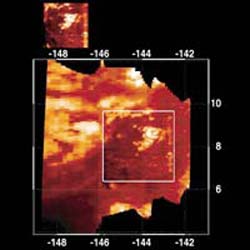Titan’s volcano may release methane

Possible volcanic dome on Titan ocean
A team of European and US scientists, using Cassini-Huygens data, have found that Saturn’s smoggy moon Titan may have volcanoes that release methane in the atmosphere.
These findings may lead scientists to revise the theories that the presence of methane in Titan’s atmosphere is mainly due to the presence of a methane-rich hydrocarbon ocean.
Infrared images taken by the Visual and Infrared Mapping Spectrometer (VIMS) on board the Cassini orbiter, show a bright, 30-kilometre-wide structure. This structure, imaged during the first Titan fly-by on 26 October 2004 from a distance of 1200 kilometres, could be interpreted as a volcanic dome formed by upwelling plumes of icy material that rose to the planet’s surface. While melting, the icy material contaminated by hydrocarbons would release methane gas.
The eruptions of such an ice-volcano, or ‘cryo-volcano’, would be caused by the heat generated during tidal movements of material inside Titan. Internal tides at Titan are expected as this moon strongly varies its distance from Saturn while it runs along its highly elliptical orbit around the mother planet.
The images of the observed area also show that liquid is not visible on the surface. This conclusion is reinforced by the comparison of surface features imaged by VIMS with similar features imaged by ESA’s Huygens probe during its descent and eventual landing onto Titan’s soil.
“Before Cassini-Huygens, the most widely accepted explanation for the presence of methane in Titan’s atmosphere was the presence of a methane-rich hydrocarbon ocean,” said Dr. Christophe Sotin, from the University of Nantes (France) and lead author of the results. “The suite of instruments on-board Cassini and the observations at the Huygens landing site reveal that a global ocean is not present. Interpreting this feature as a ‘cryo-volcano’ provides an alternative explanation for the presence of methane in Titan’s atmosphere”, he added.
An infrared instrument like VIMS is able to peer through Titan’s dense haze and provide information about the chemical composition and the topography of the surface.
The highest resolution image obtained covers an area 150 square kilometres that includes the bright 30-kilometre circular feature, with two elongated wings extending westward. This structure actually resembles volcanic structures on Earth and Venus, with overlapping layers of material from a series of flows, although the volcanic material is different.
In the centre of the area, scientists clearly see a dark feature that can be interpreted as a depression. So, it is easy to imagine it as a volcanic caldera, a bowl-shaped structure formed above chambers of molten material.
If the cryo-volcanism hypothesis is true, the black channels seen by Huygens during its descent could have been formed by the large release of methane-rich rains following the eruptions.
Scientists have already considered, and ruled out, other interpretations for the 30-kilometre circular structure. In principle, it could be a cloud, but images taken at different times show that the structure does not vary its shape. A second interpretation would suggest that the structure is an accumulation of solid particles transported by gas or liquid, as it happens for sand dunes on Earth. However, a circular shape does not really match with this process, and its possible wind patterns do not match with the expected wind directions on Titan.
Radar observations of the same regions to be made later by Cassini will certainly help to confirm these findings.
Media Contact
More Information:
http://www.esa.int/SPECIALS/Cassini-Huygens/SEM1531DU8E_0.htmlAll latest news from the category: Physics and Astronomy
This area deals with the fundamental laws and building blocks of nature and how they interact, the properties and the behavior of matter, and research into space and time and their structures.
innovations-report provides in-depth reports and articles on subjects such as astrophysics, laser technologies, nuclear, quantum, particle and solid-state physics, nanotechnologies, planetary research and findings (Mars, Venus) and developments related to the Hubble Telescope.
Newest articles

Properties of new materials for microchips
… can now be measured well. Reseachers of Delft University of Technology demonstrated measuring performance properties of ultrathin silicon membranes. Making ever smaller and more powerful chips requires new ultrathin…

Floating solar’s potential
… to support sustainable development by addressing climate, water, and energy goals holistically. A new study published this week in Nature Energy raises the potential for floating solar photovoltaics (FPV)…

Skyrmions move at record speeds
… a step towards the computing of the future. An international research team led by scientists from the CNRS1 has discovered that the magnetic nanobubbles2 known as skyrmions can be…





















